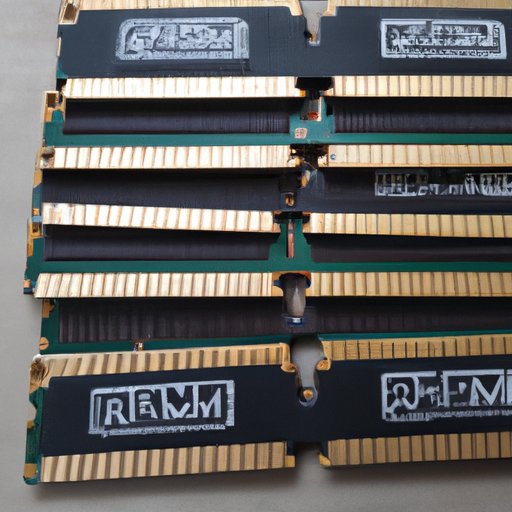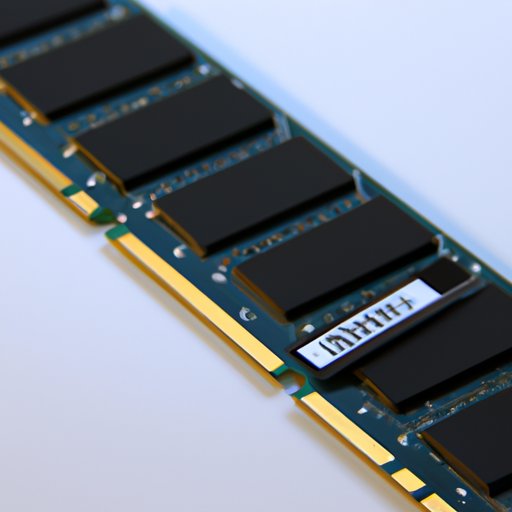Introduction
Random Access Memory (RAM) is a type of computer memory used to store data temporarily while a computer is running programs. It is an essential component of any computer and plays a major role in its performance. In this article, we will explore what RAM is, its purpose, and how it works to improve computer performance.

Explaining RAM Basics and Its Role in Computer Performance
RAM is a type of volatile memory, meaning that its contents are erased when the power is switched off. It is used to store data and instructions for immediate use as the computer performs tasks. This data is stored as bits, which are either 0 or 1. RAM also stores variables, such as numbers or text, and program code.
The memory types of RAM include DRAM (Dynamic Random Access Memory), SRAM (Static Random Access Memory), and DDR SDRAM (Double Data Rate Synchronous Dynamic Random Access Memory). Each type of RAM has different storage capacities, from 4GB to 16GB or more. The amount of RAM installed in your computer determines how many applications and processes you can run at the same time.
The primary function of RAM is to hold data and instructions for the CPU (Central Processing Unit) to access quickly. When the CPU needs information, it can access RAM much faster than it can access data stored on a hard drive. As a result, RAM improves the speed of computing operations and increases system performance.

Different Types of RAM and Their Benefits
DRAM (Dynamic Random Access Memory) is the most common type of RAM used in computers today. It consists of small capacitors that store electric charge with each bit representing either 1 or 0. DRAM is relatively inexpensive and has high storage capacity, but it also requires frequent refreshing to maintain data integrity.
SRAM (Static Random Access Memory) is faster than DRAM but more expensive. It does not require refreshing like DRAM, so it can be accessed faster. However, its storage capacity is limited compared to DRAM.
DDR SDRAM (Double Data Rate Synchronous Dynamic Random Access Memory) is the most recent type of RAM and is even faster than SRAM. It operates at higher frequencies and has greater bandwidth, resulting in improved performance. DDR SDRAM is more expensive than other types of RAM but is becoming increasingly popular.

The Role of RAM in System Performance and Speed
RAM plays an important role in system performance and speed. When a computer runs a program, the CPU reads data from RAM instead of the hard drive. This reduces the amount of time it takes to process data, resulting in faster loading times and better overall performance.
RAM also allows for multitasking, or running multiple applications or processes at the same time. Without enough RAM, the computer may become sluggish and unresponsive when switching between applications. Having enough RAM ensures that the computer can handle multiple tasks without slowing down.
Finally, RAM provides virtual memory, which is a type of secondary storage used when RAM is full. When RAM is full, the computer stores data on the hard drive temporarily until RAM becomes available again. This ensures that the CPU has access to the data it needs, resulting in faster processing times.
How to Upgrade Your RAM to Improve Computer Performance
If your computer is feeling sluggish or unresponsive, upgrading your RAM is one of the easiest and most effective ways to improve its performance. Here are some steps to help you upgrade your RAM:
1. Determine your current RAM type and amount. Start by opening the Task Manager and checking the “Performance” tab to see how much RAM your computer currently has installed.
2. Check your motherboard’s compatibility. Make sure that your motherboard supports the type and amount of RAM you want to install. Most motherboards have limits on the maximum amount of RAM they can support.
3. Install the new RAM. Once you’ve determined that your motherboard is compatible with the RAM you want to install, follow the instructions in your computer’s manual to install the new RAM properly.
Conclusion
In conclusion, RAM is an essential component of any computer. It is used to store data and instructions for the CPU to access quickly, resulting in improved system performance and speed. Different types of RAM offer varying levels of performance and storage capabilities. Upgrading your RAM is an easy and effective way to improve your computer’s performance.
(Note: Is this article not meeting your expectations? Do you have knowledge or insights to share? Unlock new opportunities and expand your reach by joining our authors team. Click Registration to join us and share your expertise with our readers.)
